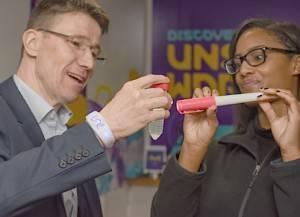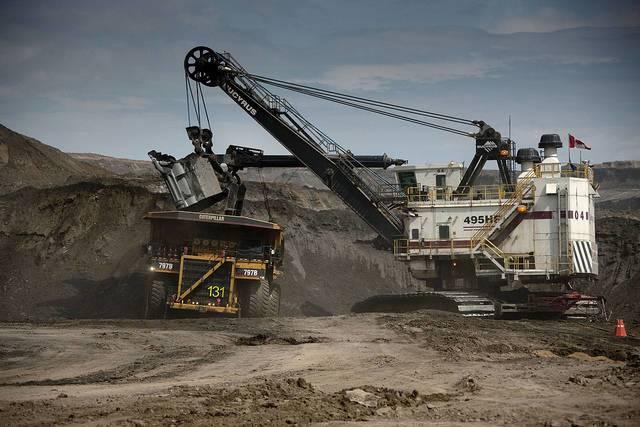Sparking Curiosity to Drive Tomorrow’s Scientists and Innovators


By Jeffrey Whitford
Curiosity, in my view, is one of the driving forces behind everything we do—and everything we are capable of doing. Through curiosity in science, I believe we are given a unique way to help make a difference. Or, as we like to say at MilliporeSigma, science enables us to help solve the world’s toughest problems.
Yet, despite its limitless possibilities, science education isn’t what it once was. Due to changes in education policy globally and financial constraints, science education for most students no longer includes hands-on labs or the ability to connect to careers and professionals. This leaves students less likely to choose a career in the sciences—even though STEM careers pay 26 percent more than non-STEM careers. And, this issue isn’t just about the students; it’s also about the teachers. Reduced funding and a focus on standardized test performance have put many teachers at a disadvantage for teaching STEM subjects.
As head of corporate responsibility for a life science company that relies heavily on a STEM-ready workforce, I am both a witness and participant in conversations with colleagues, customers, community leaders and corporate responsibility peers on ways to re-ignite interest in science and STEM. And, I’m fortunate to work for a company that is not just committing financial resources, but is also contributing the experience and expertise of its workforce to create stronger STEM ecosystems in the communities in which we operate and live.
Tapping Our Greatest Assets: Employees and Partners
With resounding support from our employees, in 2016 we launched SPARK—a global skills-based volunteer program that taps our network of 19,000 employees to bring science to life in classrooms around the world.
We collaborated with the Institute for School Partnership at Washington University to develop an inquiry-based, hands-on science curriculum catalog—the Curiosity Labs™ program—using the Next Generation Science Standards (NGSS). Through this program, delivered by employee volunteers with materials we provide, students engage in experiments used in real-world applications such as DNA extraction, to chemiluminescence, to water filtration. And, we use these opportunities to talk with students about careers in science.
We continued to invest in teacher education through partnerships with like-minded public and private sector organizations through our membership in organizations such as STEMpact in St. Louis, MO.
We are encouraged by what we’ve heard from the more than 40,000 students around the world who experienced a Curiosity Labs™ lesson over the past year:
- 79% reported an increase in content knowledge.
- 80% demonstrated confidence in science by indicating they know “quite a bit” or “very much” about science.
- 81% stated that they enjoy science.
We recognize that keeping this spark alive will require more from us. So, this year, we are planning on adding four new lessons to our already extensive Curiosity Labs™ curriculum to find new ways to showcase how science is exciting and relevant in real life.
To help us expand our reach, we recently introduced the Curiosity Cube™—a 22×10 retrofitted shipping container that has been transformed into a mobile science lab with hands-on activities built on the Curiosity Labs™ lessons. We are piloting the Curiosity Cube™ in the U.S. this year, with a goal of visiting more than two dozen cities across the country to reach 350,000 curious minds of all ages. The Curiosity Cube™ will also make a special appearance at select STEM-related trade shows—giving current and future leaders in STEM a chance to experience curiosity in action.
What and how students learn today will impact their decisions tomorrow. By providing both students and teachers with the tools they need—and engaging families in the process—we hope to spark enough curiosity to make an impact that will last generations. I hope you will #SparkCuriosity with the children in your life.
To learn more about our Curiosity Labs™ program please visit www.sigma.com/curiositylabs.
Shell, Like ExxonMobil, Knew About Climate Change Risks All Along


It turns out ExxonMobil, now under numerous investigations over climate research it allegedly stifled decades ago, was not the only energy company looking into the effects of climate change decades ago. Shell also conducted early climate change research, and even produced an educational video on the subject in the early 1990s.
The video resurfaced due to research by Jelmer Mommers of the Dutch blog The Correspondent and was discussed in greater detail by Damian Carrington of the Guardian. The 1991 film painted a rather stark vision of the 21st century world if climate change was not addressed. At 28 minutes long, the film “Climate of Concern” was created by Shell for distribution to school and universities.
Shell’s film predicted a fairly accurate world in which we live in now: Fracking has become a mainstream technology used to harvest natural gas; floods happen with greater frequency; and the links between climate change and social conflict are more obvious.
And according to the video, computer modeling conducted in the late 1980s and early 1990s suggested that the earth’s climate could increase 1.5 degrees Celsius by 2050. That estimate is prescient 25 years later, considering that the scientific consensus now estimates the world will warm another 2 degrees Celsius by mid-century.
Throughout the film, the narrator makes it clear that greater action is needed in order to reverse climate change risks. As one watches the production, the setting could be anywhere in 1991 or 2017, as the film touches on the impacts of climate volatility on countries such as Bangladesh, in addition to potential low-carbon technologies that could reduce such risks.
The video starts on an ominous note:
“Research of this kind is being stepped up worldwide. The need to understand the interplay of atmosphere and oceans has been given a new sense of urgency by the realization that our energy-consuming way of life may be causing climatic changes, with adverse consequences or us all.”
Carrington of the Guardian also scored access to a confidential Shell report from 1986, which suggested that climate change caused by human activity would cause some of the greatest changes in history.
“Action now is seen as the only safe insurance, but what should that action be?” asks the film at its halfway point.
Shell now claims it can answer that question by pointing to its call for a carbon tax, its carbon capture project in Alberta, Canada, or even its investments in renewables such as an offshore wind power installation off the coast of the Netherlands.
Indeed, Shell warned the world about climate risks a year before George H. W. Bush mocked vice presidential candidate Al Gore as the “Ozone Man” during the former’s failed reelection campaign. But critics of the Dutch-Anglo energy giant say the company’s promotion of fossil fuels far outweighed any renewables investment or climate action.
Documents revealed in 2015 show that Shell aggressively lobbied for years to reduce the European Union’s renewable energy targets. In fact, during 2015, Shell spent $22 million worldwide to blunt governments' efforts to implement climate change goals.
Those actions counter the stance Shell makes on its own sustainability website, as the company claims it welcomes “efforts made by governments to cooperatively reach the global climate agreement” accomplished at the December 2015 COP21 climate talks in Paris.
Shell's insistence on talking out of both sides of its mouth puts investors at risk, as many of its projects, such as its stake in Alberta's tar sands, end up becoming stranded assets.
Image credit: Shell/Flickr
This Vertical Farm Wants to Pioneer 'Post-Organic' Food


Once upon a time, every farmer on earth practiced something called organic agriculture, although they never bothered to coin the phrase.
The cultivators of this amazing pre-industrial concept spent their days diligently tending and harvesting their crops without the aid of manufactured products. They protected their plants with things no longer in abundance: worms, snails, ladybugs, and a full arsenal of homeopathic concoctions passed down from hundreds of years of ancestral heritage. And it was, for sure, a tough row to hoe.
Today’s natural agriculture is still organic by definition, but the mechanics to raising that chemical-free produce are a world away from what your parents might have tried in their backyard.
Most states have regulations and long lists that define organic agriculture and what can, by law, be used during large-scale organic farming. And while today's organic farms may skillfully manage to avoid the use of controversial chemical sprays with complicated names like permethrin and thiamethoxam (which have both been suspected of contributing to the decline in bee colonies), they typically rely on concentrated non-chemical fungicides and pesticides for large-scale production.
An entrepreneur in Kearny, New Jersey, thinks he’s found the next evolution for agriculture: post-organic. If that doesn’t sound like a very inventive name for a process, the system itself makes up for it.
Irving Fain’s concept of farming does away with the swaths of green space we normally associate with wholesome agriculture. He traded acreage for an urban warehouse, a carefully-managed environment and a proprietary technology that produces food 100 times faster than conventional farming. And all of that without pesticides, soil stimulants or other additives, Fain and his company claim.
Warehouse-based vertical farming isn’t entirely new. Farmers have been dabbling in various versions of indoor farming for centuries, finding new ways to capitalize on its water-saving techniques and, in so doing, finding faster ways to ensure quality production.
But Fain's company, Bowery Farming, uses its own self-automated technology to respond to and manipulate the environmental factors upon which plants rely.
And unlike most full-scale indoor farming operations, Bowery’s system can “sense” when it’s time to pluck the crops – something that is usually done by sight and schedule in conventional farms. That means less wasted product and more predictable harvesting seasons. It also means a more predictable bottom line.
The company shared this glimpse inside its vertical farm on Instagram:
So far the company's 'post-organic' greens are available in two Manhattan restaurants, a pair of Whole Foods Market stores in New Jersey, and Foragers Market in New York's Chelsea neighborhood.
With increasing concerns about drought and climate change, vertical farms that can operate in limited space with less water and virtually no natural sun may become the next stage in agriculture.
Whether the 'post-organic' concept will eventually be able to overtake the organic market’s sizable revenues ($43 billion yearly), remains to be seen. But in there’s something to be said for an industry that uses 95 percent less water than conventional farming and won’t wither with climate change.
Image credit: Pixabay
Berlin’s Transport Secretary is Determined to Phase Out the Automobile


As far as the world’s smart cities go, Berlin can hold its own. Solar rooftop installations comprise a healthy business – despite a temporary moratorium last year – and urban farming thrives in Germany’s capital. City leaders are quick to tout their efforts to streamline bureaucracy and make government more responsible to citizens’ needs. The city has also committed to smarter office buildings and homes where citizens working within its burgeoning technology sector can live and work.
But Berlin’s cultural offerings, nightlife and relatively cheap cost of living compared to other large European cities have exacted a toll on the city of 3.5 million. Its population is projected to reach 4 million within a decade, which will cause further spikes in rent and home prices while increasing traffic congestion.
Enter Berlin’s transportation secretary, Jens-Holger Kirchner. In an interview last month with the German daily Der Tagesspiegel, Kirchner bluntly gave his opinion of cars: “Whoever drives a car in Berlin has too much time,” he said, and he sees better city planning, with an emphasis on bicycling, as key to alleviate Berlin’s traffic.
A member of Germany’s Green Party, Kirchner is determined to use his clout as head of Berlin’s newly formed Department for the Environment, Transport and Climate Protection to pursue his agenda. In his view, if automobile manufacturers cannot or will not make their cars run cleaner, Berlin will simply see fewer of them on the city’s streets.
By many metrics, Berlin’s transportation system is less carbon-intensive when compared to many global cities of a similar population. According to a recent London School of Economics study, almost 40 percent of Berliners take some form of public transportation to work, while just over a third rely on their own cars. Walking and cycling both make up 14 percent of city residents’ mode of commuting. Furthermore, car ownership is on a slight decline, with 3.6 percent fewer cars in 2013 than 2010.
But those statistics do seem to not satisfy Kirchner. Claiming that he is a “multimodal” commuter himself – relying on a city-issued hybrid vehicle, walking, cycling and public transport in order to move around town -- Kirchner says even more improvements can be made to reduce the city’s congestion. His vision is to boost bicycle commuting by up to 50 percent, which would perch Berlin alongside what many describe as the world’s cycling capital, Copenhagen.
Kirchner’s drive to boost cycling across Berlin is not only about the environment, but also about public safety. To that end, he supported a project that seeks to use electric bicycles for that “last mile” of deliveries within the city. His department will also oversee the launch of a new citywide bicycling-sharing system, which will compete with a another bike-sharing program largely funded by a Lidl, the $90 billion German-owned global discount supermarket chain.
Meanwhile, Berlin citizens are taking matters into their own hands. In late 2015, cycling advocates launched a petition drive to put an aggressive set of laws they say will boost bicycle ownership and commuting to a citywide vote. Supporters say such a plan would also help the city meet its carbon reduction targets, on which Berlin keeps falling short.
City leaders, however, say Berlin’s infrastructure is more “complicated” than what this referendum aims to achieve.
Kirchner has not explicitly said whether he supports that effort, but if he has his way, bicycles will become an even more common sight across Berlin.
Image credit: 8bar Bikes/Flickr
RSPO: Sustainable Palm Oil is Growing Worldwide


By Dan Strechay, RSPO
Oil palm is a paradox. It’s a crop that by any measure has created a tremendous amount of both social strife and environmental damage. Be it the destruction of millions of acres of primary forest -- on several continents -- or the relentless pressure on endangered species such as the Sumatran Tiger, Orangutan, and many other mammals, birds and insects. Many of these animals have even been driven to the edge of extinction.
This is an industry built on a system of agricultural production -- the plantation -- introduced two millennia ago by the Romans and literally on the backs of slaves. And still today, the supply chain contains forced labor, child labor and human rights abuses. There are countless examples of land grabs by companies as they look to either circumvent local laws or the opposition of the local communities. And we still have local, regional, and national governments making it illegal to publish palm oil concession or plantation maps -- further delaying transparency.
Yet at the same time, this same crop -- the oil palm -- has positive sustainability attributes. Yes, that same oil palm that has caused all of the above.
It’s a perennial oilseed that is productive for approximately 25 years, and it produces fresh fruit bunches all year long -- giving farmers a stable yearly income. And, the oil palm has four to 10 times the yield per hectare than other oil seeds. For example, palm is roughly 6 percent of the planted acres of oil seeds, but represents roughly 38 percent of the vegetable oil market.
Additionally, this is a crop that helped pull hundreds of thousands of people out of poverty and empowered the populations of nations like Indonesia and Malaysia. For example, in 1984, almost 72 percent of Indonesians lived on $1.90 a day or less. By 2010, that number dropped to less than 16 percent. For better or worse, palm oil played a large role in this improvement in living standards. Now we see Latin American and African nations looking at these statics and wondering if there isn’t a role for palm oil in their economies, either to alleviate poverty or to diversify their economies.
That’s why it’s so important to ensure palm oil is produced sustainably. It has the ability to help the world’s poorest communities if we strike the right balance between where it is developed and how it is grown.
That’s why -- despite the criticism and challenges -- we at the Roundtable on Sustainable Palm Oil (RSPO) continue to do the work we do every day and push the palm oil industry to transform itself into one that is responsible and sustainable. We know that we must continuously improve; we must work with other organizations to grow the volumes of certified sustainable palm oil that is both produced and bought; and we must innovate based on what we have learned since our founding in 2004.
Continuous Improvement is paramount to our organization as it is all other organizations. We are a member-based, multi-stakeholder organization encompassing the full supply chain that has continued to evolve since our founding. The eight principles of the RSPO Principles & Criteria (P&C) cover social, environmental and economic betterment, with a focus on continuous improvement.
We understood from the outset that we didn’t have all the answers. With the upcoming review and re-adoption of our P&C in 2018, our membership will once again have the ability to demonstrate transparently and openly the constant and steady evolution of the standard. This will happen through a decision-making process driven by consensus, allowing for inclusivity to drive market transformation.
If we consider that today RSPO certifies roughly 20 percent of the palm oil supply, approximately 80 percent is still outside of our certification system. As much as we would like to, we cannot provide oversight of the whole palm oil industry at this time. It is crucial that we all work to bring this 80 percent into what should be the mainstream -- responsibly-sourced, certified and sustainable palm oil.
We won’t get there with boycotts of palm oil or by presenting simplified solutions that only fit the Western consuming markets. Our solutions must be inclusive and global in nature.
And we can do that by continuing to innovate our standard while our membership continues to grow. This year will also see the launch of RSPO NEXT credits, a system that rewards growers and millers for implementing a set of voluntary add-on criteria to the standard RSPO P&C.
These enhanced guidelines or add-ons focus on the areas of no deforestation, no fire, no planting on peat, reduction of greenhouse gases, respect for human rights, and transparency. And they are applied at an organization-wide level, including investments, joint ventures and in the company’s wider supply base.
Work is now taking place to certify the first RSPO NEXT plantations in several geographies, which will then launch the RSPO NEXT credits market. We believe there will be robust demand for these credits and that in turn will push even more growers to become RSPO NEXT certified.
Further, we have launched three pilots on what is a new Jurisdictional Approach, or “landscape approach,” to certification. In Sabah, Malaysia, and Central Kalimantan and South Sumatra, Indonesia, we are working to implement certification at the provincial level -- not just islands of certification, but whole provinces certified under the RSPO standard.
In Latin America, the government of Ecuador has embraced this approach for the whole of its palm oil industry.
This is a complicated endeavor, but the results thus far have been very encouraging.
We welcome the role of constructive criticism of our organization identifying where we can improve. We believe that we have achieved a lot -- not alone but with all stakeholders within our organization -- and that we can achieve more as we focus on what’s within our control. At the same time, we will continue working with other stakeholders to grow our mission and membership, always with a focus on continuous improvement, as we foster innovation of the standard and the P&C.
We have a mission to make sustainable palm oil the norm. By our measure, we’re a fifth of the way there. We know that’s not fast enough for some, and even for ourselves. But we also know that is a fifth further along than we were. We will only get there if we all work toward this common goal.
Image credit: Flickr/CIFOR
Dan Strechay is the U.S. Representative, Outreach and Engagement for the Roundtable on Sustainable Palm Oil (RSPO).
As Feds Devalue Science, It's Time To Take It to the City


A pivotal conversation in Chicago galvanized my career in adaptation. A group of scientists from Washington, D.C., were visiting as part of a roadshow preceding the rewrite of the National Climate Assessment. After an hour of posturing and talking at us, they asked if there were questions.
I couldn’t help myself. I gave them a verbal licking for assuming that we practitioners knew nothing of science – or anything really. It shushed the room and opened the door to many excellent speaking engagements, where I often was the token practitioner on a panel of scientists.
During one such panel session, after a climate scientist wowed a room of Doctors Without Borders physicians by describing changes expected from extreme heat, vector-borne disease and extreme weather events, the first question to the scientist was: “What should we do about these risks?” The scientist responded, “I don’t know. I make science. You guys are the ones with the solutions.”
What?
Perhaps in this era when science seems so devalued at the federal level, we possess an exceptional opportunity to bring science to cities. Indeed, many cities wish they had the bandwidth to increase the evaluation of evidence to shore up their decisions.
Not all scientists are averse to digging into local issues and suggesting solutions. When I led implementation of the Chicago Climate Action Plan, I benefited from two incredible science rock stars who prepared the city’s climate risk assessment: Katherine Hayhoe and Don Wuebbles. And, of course, the New York City Panel on Climate Change is a respected and relatively well-known local scientific engagement.
So, if you’re frustrated that U.S. Environmental Protection Agency regulations might be rolled back, recognize that local government can be a way to control private-sector environmental harms. If you’re worried that federal data and tools have been removed from the public domain, take your data and tools to a city’s public domain. If you’re unsure how you can make an impact on the world without the federal government’s support, consider all that cities have done and have the power to do.
While scientists and their supporters rearrange their packed schedules to participate in the March for Science later this spring “to support and safeguard the scientific community,” I encourage you to look up your mayor’s office and make an appointment for a chat. And I do mean your mayor. It doesn’t have to be Chicago Mayor Rahm Emmanuel or any big-city chief executive. What about the mayor of your mom’s town? You could return as the prodigal son or daughter.
When you secure a meeting, prepare a three-sentence overview of what you do. Not a book or even a short bio. After brief introductions, start the meeting with such questions as:
- What sort of science do you need?
- What department heads are using science in their work right now?
- How can a scientist be helpful to your work?
- What innovation are you most proud of?
- What most needs work?
Then listen. If in this first conversation you talk 15 percent of the time and listen the other 85 percent, you have succeeded.
And please don’t follow up with half a dozen peer-reviewed articles that raise complex questions and end with complex questions in tiny print. That just reminds your city friends of the gulf between your research and their practice.
Instead, suggest ways to reframe their questions, offer ideas for solutions from the literature, put them in touch with knowledgeable scientific colleagues, and create your own “support and safeguards for the scientific community” -- in your actual community.
Now, proceed, scientists, to make some science in the city. You might find it invigorating.
Image credit: Pexels
Joyce Coffee, LEED AP, is president of Climate Resilience Consulting, https://www.climateresilienceconsulting.com/, working with leaders to create strategies that protect and enhance markets and livelihoods through adaptation to climate change. She also collaborates with scientists at Arizona State University on the Urban Resilience to Extremes Strategic Research Network. Previously, she worked with the University of Notre Dame Environmental Change Initiatives’ “Science Serving Society” as managing director of the Global Adaptation Initiative. Earlier in her career, she led implementation of the Chicago Climate Action Plan @joycecoffee.
Technology Is Putting Women Out of Work -- Here's How to Counter the Effects


By Sona Jepsen
It’s nice to think that social issues like gender equality are further along than ever before. Too bad that’s not exactly the truth. According to the 2016 Global Gender Gap Report from the World Economic Forum, the gender gap is at its widest since 2008 — and isn’t projected to close until the year 2186.
Technology may have more to do with that than you think. It has long been a concern that technology is replacing people in the labor force, but less talked about is how these advances specifically affect women in the workplace.
Yes, women are leaning in and breaking down boardroom doors, but automation is simultaneously putting many of them out of work. Technological advances are automating jobs women typically dominated, such as sales and admin work.
Meanwhile, according to the WEF, men are projected to gain 600,000 jobs in architecture, engineering, computer sciences and math by the year 2020. Women will gain only 100,000 jobs in the same categories. So while science and technology advance at a rapid pace, offering new opportunities in the workplace, women are in danger of being left behind.
This is a man's (and a machine's) world
We are not only seeing job growth in male-dominated industries, but we are also seeing technology slowly replacing jobs where women were the majority.
The solution? We need to accelerate the rate at which women enter the STEM (science, technology, engineering and math) fields by evolving the work environment to support women and coach them to move into leadership positions.
Companies that offer women fair pay and an even playing field will reap the rewards of improved business performance over companies that continue to undervalue women.
Here are some essential principles that leaders can use to ensure they’re doing their part to help things along:
1. Equip teams to collaborate seamlessly from anywhere: When it comes to collaboration, consider the daily experience of a typical employee. It should be fun, not frustrating -- no matter where workers have to dial in from. According to the U.S. Bureau of Labor Statistics, 24 percent of the labor force did some or all of their work from home in 2015, and that number is only expected to keep rising.
Because working from home is slowly but surely becoming the norm, upgrading and streamlining communication processes will make this approach more feasible without hurting business progress or the camaraderie between employees. Remote work also makes it easier for skilled, talented women to re-enter corporate America after having children, giving them more flexibility and shrinking the gender gap.
2. Hire for a wider range of traits and behaviors: Women in the workplace often struggle to conform to the traditionally lauded “leadership skills” that are expected of them. Qualities such as assertiveness and outspokenness can be misconstrued as negative when women exude them. By celebrating a wider range of behaviors in a work environment, a greater diversity of ideas — and bodies — can be represented.
Google has arguably become the gold standard for developing and supporting a diverse group of employees. The company developed a tool that sends hiring managers suggested questions corresponding with the roles they're screening for, but those questions aren't just about what looks good on a résumé. Utilizing these questions helps the company predict performance by focusing on behavioral indicators and leadership potential.
There’s no need to build a fancy tool in order to apply the same principle. Remember: Experience and education don’t guarantee performance. Hiring and promoting the right behaviors and personality traits for a company’s culture will be more beneficial in the long run — and will open operations up to a larger pool of candidates.
3. Exude authenticity in all efforts: When companies are genuine and authentic in both outward practices and internal dynamics, they attract similarly genuine employees. If leadership is looking to create a more inclusive atmosphere for all genders, it’s acceptable to admit that. Engaged employees will happily provide feedback on how to create a supportive environment for everyone.
And it’s important to hire like-minded authentic talent, rather than just the candidates with the expected résumés. Women who possess the right talents for a position may not have that reflected in a job history, so learning to spot potential can be a valuable asset in discovering high-quality candidates. Team members can separate true-grit talent from the workers who just say what people want to hear.
Here’s the bottom line: A diverse group of people with different backgrounds and experiences who collaborate well can give companies the competitive edge. That’s what can keep a business plowing forward when others crumble. Meanwhile, leaders who seek diversity help to close the gender gap — and that means everyone wins.
Image credit: Eutah Mizushima via Unsplash
Sona Jepsen is the global head of sales enablement at Fidelity National Information Services (FIS). Her team empowers FIS’ global sales teams with sales content, strategic insights, and world-class learning and development opportunities.
How New Businesses Can Connect With Their Communities


By Ari Rabban
Have you ever walked over to the neighbor’s house and ask to borrow a cup of sugar? Me neither. It’s an antiquated idea harkening back to 1950s suburbia, but close relationships within the community were once a necessity of life.
Of course, in the business world, the need for community connection still holds true.
Whether you are opening a bakery or starting a tech company, building relationships within your own ZIP code can be vital — both for your success and for the community itself. A Civic Economics study showed that buying locally resulted in 68 percent of every dollar ultimately being generated for the local economy, compared with 43 percent when people spent money at chains. Still more studies reveal that consumers tend to reward companies that invest in their own communities’ development.
Business leaders who actively engage and communicate with community leaders earn much more than dollar bills. They receive introductions to legal, accounting, real estate, human resources and other services, expanding their circle of influence and helping to create a more vibrant community. As that reciprocity increases, so does your business’s reputation and success.
Thriving community, thriving business
Even outside the monetary or PR benefits, community outreach is quite simply an enriching experience and one that I’ve had the good fortune to enjoy firsthand.
As soon as my company, Phone.com, was up and running, we jumped right in and immersed ourselves in Newark, New Jersey’s tech community: We went to events, networked, volunteered, mentored, and sponsored as much as we could within our budget limitations. Over time, we were invited to more events to speak or exhibit, which led to all sorts of new business channels.
We were even given the opportunity to help the city’s infrastructure with cloud-based PBX phone service for multiple city offices while reducing the total cost for phone service ownership. The partnership made sense but would have been unthinkable if my team hadn’t been a part of our community’s entrepreneurial ecosystem from the start.
Reaching your community where they live
To connect with those in your geographic area, you must build meaningful, collaborative relationships. Such relationships form a bedrock of trust that can positively affect the community in far-reaching ways. Begin your company’s immersion project through pragmatic actions:
1. Plug into local boards and chambers: Not everyone starts off as a third-generation business owner in a small town where the whole community knows them and will automatically buy from them. To build visibility for your organization, join your regional or state trade association or local Chamber of Commerce.
Don’t worry about rising up in the ranks — just prove that you’re there to lend a hand. This opens the path to new business, as well as introductions to future customers, partners and business channels.
2. Engage industry journalists and community leaders: Many new business leaders try to get their names out by spending every marketing dollar they have. Instead, do your reading. Find all the local reporters, bloggers and pundits covering your industry. Create a list of these players, and follow up with them.
Not only will you get to know your community, but you will also make essential inroads with these journalists and community leaders. As you become more appreciated and liked, you will increase your network and inevitably help grow your company.
3. Join business networking groups — or create your own: Private “clubs” — like local chapters of Business Network International — are a great jumping-off point. As a member, you will contribute your knowledge to others, and in return you will get the right tips you need. Exchanging ideas and contacts can result in immediate business, building the foundation for further success down the road.
You will always need your community, even if it’s only for plumbing help, catering services or the occasional cup of sugar. So be visible, and get involved. You may not see returns right away, but have patience — after all, good deeds fuel amazing outcomes.
Image credit: Pexels
Ari Rabban is the CEO of Phone.com and a veteran of the IP communications industry. Phone.com’s virtual phone service builds on the digital VoIP industry experience of its founders to deliver a complete suite of enterprise-grade unified communication services at an SMB price. Ari was named among the Top 20 Most Influential People in VoIP 2012 and currently serves on several boards, including the New Jersey Tech Council. You can follow him on Twitter @arabban.
Apparel Giant VF Corp. Launches Anti-Deforestation Policy


On Monday VF Corp., the $12 billion apparel company that includes brands such as Timberland, The North Face and Vans, announced what it describes as its first “Forest Derived Materials Policy.”
The company says these new guidelines will help drive its purchasing decisions to source more sustainable forest materials and products. The promise to increase what the company can do in order to reduce deforestation builds upon the responsible sourcing policies outlined in its most recent annual report.
VF claims to partner with several NGOs including Canopy, a nonprofit that works with companies in many sectors, most notably in publishing and fashion. Canopy works with various companies such as H&M, Inditex/Zara, Levi’s, Sprint and Penguin-Random House to incorporate more sustainable raw materials into everything from textiles to paper. Materials that Canopy touts as more responsible include pulp and paper products made from agricultural waste such as straw, recycled paper and synthetic fibers derived from sources other than wood.
VF has worked to steadily clean up its supply chain in recent years. In 2013, the company reached its goal to source 1 percent of its cotton certified by the Better Cotton Initiative (BCI); VF tripled that goal in 2015. That may sound like peanuts initially, but VF says it alone purchases 1 percent of the world’s cotton. Furthermore, BCI has long struggled to meet the demand for its more sustainable cotton that is becoming even more embraced by companies such as Adidas and H&M.
The acquisition of Timberland in 2011 helped accelerate VF's commitments to sustainability. Timberland held public quarterly and annual sustainability conference calls before the was a popular buzzword within the apparel industry. And last year, the New Hampshire-based outfitter announced several new sourcing policies it plans to achieve by 2020. New manufacturing commitments include having at least one renewable, organic or recycled component in all of its footwear; 100 percent of its cotton either certified organic, from BCI or of U.S. origin; and the purchase of leather from tanneries that are only certified as silver or gold by the Leather Working Group.
Other companies under the VF umbrella have also promised to improve their materials sourcing. The North Face, for example, says it is incorporating more recycled plastic from soda and water bottles within its high-performance synthetic materials while slashing the use of water, chemicals, and energy throughout its manufacturing. And Vans is including more BCI cotton in its iconic slip-on and skateboarding shoes, and also adopted the Sustainable Apparel Coalition’s Higg index as it strives to use smarter and less wasteful packaging.
More efforts like these from VF are needed to diffuse NGOs’ accusations that the fashion industry is a major cause behind global deforestation.
The Rainforest Action Network, for example, asserts that the demand for fabrics such as viscose, rayon and modal are responsible for the felling of at least 120 million trees annually. And last year, the Switzerland-based International Union for Conservation of Nature (IUCN) estimated that as much as 20 percent of all industrial water pollution can be traced to the dyeing and processing of textiles while leading to the clear-cutting of more forests.
Image credit: Manny Valdes/Flickr
Scientists Invent Hydrogen-Sucking Sponge For Fuel Cell EVs


Hydrogen fuel cell electric vehicles have a little catching up to do compared to their battery-powered cousins. But improvements in the technology are coming thick and fast. The latest development arrives via Sandia National Laboratories, and it involves a spongy new material with "unusual and unexpected" properties.
So, why do hydrogen fuel cell EVs need a sponge?
Tackling the hydrogen storage problem
"Improvements in the technology" is a shorthand way of saying that fuel cell EVs need to come down in price before they appeal to the mass market.
For now, battery EVs are winning hearts and minds, at least when it comes to passenger cars. They're already closing in on the cost of a typical gas-powered vehicle, and the EV charging station network is growing rapidly.
Part of the affordability problem for fuel cell EVs has more to do with the fuel than the car itself. Hydrogen is an abundant fuel, but it is not particularly energy-dense. The current approach is to compress hydrogen gas for use onboard a moving vehicle, but that runs into cost issues.
The emerging solution is to trap hydrogen in a sponge-like, solid mass. Ideally, such a system would be able to store more hydrogen at a lower cost.
The sponge field is still in its early stages, said Sandia chemist Vitalie Stavila:
"There are two critical problems with existing sponges for hydrogen storage," Stavilla explained. "Most can't soak up enough hydrogen for cars. Also, the sponges don't release and absorb hydrogen fast enough, especially compared to the five minutes needed for fueling."
If you caught that thing about five-minute refueling, you're on to something. Battery EVs take a long time to charge. That's an inconvenience that inhibits mass adoption.
Fuel cell EVs only take a few minutes to charge, much like filling up a gas tank. So for zero-emission technology to replace gasoline on a massive scale, the ideal substitute would be an EV that can refuel as quickly as filling a conventional car -- and that is priced in a similar range, too.
A better sponge for fuel cell electric vehicles
That's where the new research comes in.
The study is a collaboration between Sandia, Lawrence Livermore National Laboratory, and the National Institute of Standards and Technology in the U.S., in partnership with graduate student Natchapol "Golf" Poonyayant of Thailand's Mahidol University.
Poonyayant inspired the research with his idea for leveraging nanotechnology to develop a more efficient material for hydrogen storage.
Working at the far end of the nanoscale, Poonyayant and the team developed a way to insert metals and nitrogen into particles of carbon.
The results were published in the journal Advanced Materials Interfaces under the title, "Hydrogen Storage: Nanointerface-Driven Reversible Hydrogen Storage in the Nanoconfined Li–N–H System."
The team developed tiny particles of carbon riddled with miniature pockets, which hold particles of the compound lithium nitride. Previous research shows that lithium nitride acts like a chemical "sponge" to absorb and release hydrogen. The challenge is to develop an efficient platform for managing the reaction between the two, and it looks like carbon fits the bill.
The new nanoscale material exhibits four "unusual and unexpected" characteristics that indicate a way forward, the researchers said.
Most significantly, the modified particles of carbon release hydrogen in only one step, which compares favorably to the two-step process required in a bulk material.
That leads to a second advantage. The new material also releases hydrogen more quickly than bulk material.
An important third advantage is that the new material absorbs hydrogen more rapidly, indicating the potential for rapid refueling.
Finally, the new material compares favorably to other similarly engineered materials because the "host" material -- the carbon -- can accommodate a fairly high percentage of introduced materials. The amount of lithium nitride in the carbon particles clocks in at approximately 40 percent.
So, why is it better?
One important next step is to define exactly why the new material behaves so well.
Research team members from the Livermore lab were able to determine that the nanoscale size of the lithium nitride particles -- they are only three nanometers wide -- practically eliminates inefficient, intermediate steps in the chemical reaction when absorbing and discharging hydrogen:
"Taking the path of least resistance, the material undergoes a single-step path to full hydrogenation. Similarly, once hydrogenated, the nanoparticles release hydrogen by the lowest energy pathway available, which in this case is direct hydrogen release back to lithium nitride."
The next part of the task is to achieve a more precise understanding of the mechanism at work.
The team will also work on ratcheting down the amount of carbon needed.
If this all sounds like it will take a long time, it might.
Meanwhile, even if fuel cell EVs have yet to make a mark on the passenger car market, they are beginning to emerge in other important sectors including logistics (forklifts and other work vehicles), railroads, and long-distance freight hauling.
The U.S. military is also emerging as an important market for fuel cell vehicles.
Readers please note: The research team has dedicated their work and the resulting study to Natchapol "Golf" Poonyayant, who met an untimely death at age 25 while the study was still in the writing process.
Image (cropped) via Sandia National Laboratories.